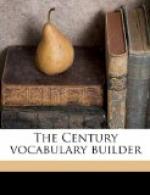EXERCISE — Literal
1. Give the specifications for a house you intend to build.
2. Make a list of comparisons (as to a nest, a haven, a goal) to show what such a house might mean in the life of a man. Expand as many of these comparisons as you can, but do not carry the process to absurd lengths. (In the figure of the nest you may mention the parent birds, their activities, the nestlings; in the figure of the haven you may mention the quiet, sheltered waters in contrast to the turbulent billows outside; in the figure of the goal you may mention the struggle necessary to reach it.)
3. Describe the looks of the house. Use as many figures of speech as you can. If you can find no appropriate figures, at least make your words specific.
4. Give a surveyor’s or a tax assessor’s or a conveyancer’s description of a piece of land. Then describe the land through figures of speech which will vivify its outward appearance or its emotional significance to the owner.
5. Observe that the Parable of the Sower (Appendix 3) is an extended figure of speech. Is the main figure effective? Are its detailed applications effective?
6. The Seven Ages of Man (Appendix 4) is also an extended figure of speech. Does it, as Shakespeare intends, bring vividly to your consciousness the course, motives, stages, evolution of a human being’s life? There are several subsidiary figures. Do these add force, definiteness to the picture Shakespeare is drawing at that moment?
7. Observe from Appendix 3, Appendix 4, and the sentences listed in Activity 9 for EXERCISE — Abstract above, that a thing meant to be concrete is likely to be stated figuratively.
8. Examine The Castaway (Appendix 5) for its proportionate use of literal and figurative elements. See Activity 2 of EXERCISE — Wordiness III above for a statement of Defoe’s purpose. Could he have effected this purpose so well had he employed more figures of speech?
9. Examine Appendix 2 for its use of figures. Are the figures appropriate to the subject matter? Are there enough of them?
10. Galvanize the thought of any sentence or paragraph in editorial (Appendix 1) by the use of a figure of speech.
11. Summarize or illustrate your opinion on any of the topics listed in Activity 1 for EXERCISE — Discourse, through the employment of figure of speech.
12. Are these figures effective?
Man is born unto trouble, as the sparks fly upward.
The flower of our young manhood is scaling the ladder
of success.
Fair as a star, when only one
Is shining in the sky.
Silence, like a poultice, comes
To heal the blows of sound.
In my head
Many thoughts of trouble come,
Like to flies upon a plum!
Let me tell you first about those barnacles that clog the wheels of society by poisoning the springs of rectitude with their upas-like eye.




